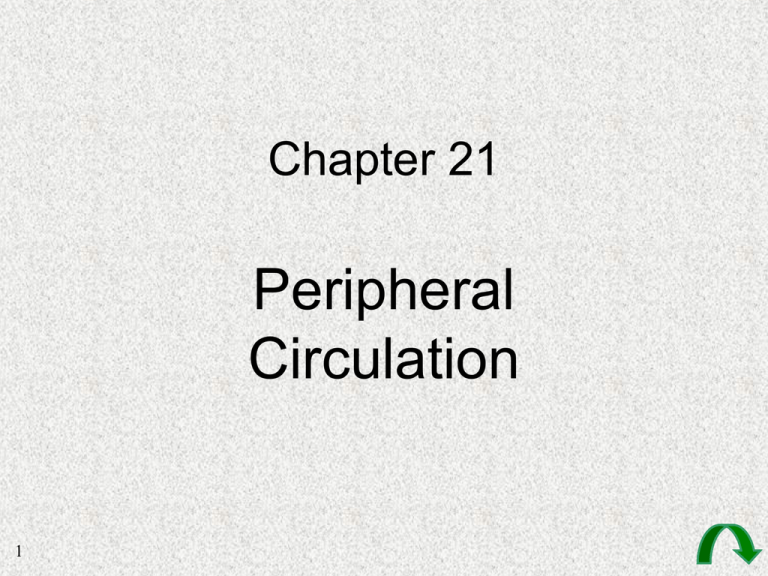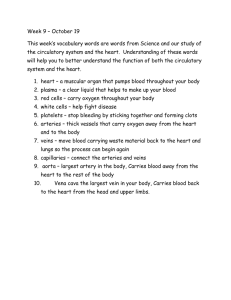Peripheral Circulation Chapter 21 1
advertisement

Chapter 21 Peripheral Circulation 1 Arteries – Capillaries - Veins General pattern of blood flow from heart to body tissues & back to heart… Arteries - leaving heart (generally O2 rich) Capillary networks/beds - in tissues Veins – return to heart (generally O2 poor) exception: in pulmonary arteries/veins O2 status is reversed 2 Arteries – General Info As distance from heart increases, arteries decrease in size increase in branching Types of arteries include: Elastic largest & closest to heart Muscular mid-range Arterioles smallest & furthest from heart 3 Veins – General Info As distance from heart decreases, merge to form larger veins thus: increase in size decrease in branching Types of veins include: venules smallest & closest to capillary bed small veins medium veins large veins 4 Capillaries (simplest vessels) ALL blood vessels have an inner lining of simple squamous epithelium. (endothelium) This innermost lining resting on a supporting basement membrane is the entire structure for capillaries Size of typical capillary = 7 – 9 μm Interior lumen is sufficiently large to allow RBCs to pass single file 5 6 Types of Capillaries Continuous – no gaps in endothelium least permeable type Fenestrated (windowed) – these have numerous gaps (fenestrae) in capillary walls 70-100 μm in diameter (of gap). found in kidney, choroid plexus of brain, intestine Sinusoidal – largest type… also have fenestrae. Basement membrane is reduced or absent. Venous sinuses – specialized regions in spleen even larger than sinusoidal capillaries – very large gaps in endothelium 7 Typical Capillary Bed Blood approaches the capillary bed in arterioles (smallest arteries) Metarterioles & Thoroughfare channels Entry is controlled by precapillary sphincters as blood flows into: arterial capillaries venous capillaries venules 8 9 10 Typical Blood Vessel Wall Several layers (tunics) stacked in a tube within tube pattern Tunica Adventitia – outermost layer – connective tissue Tunica Media – muscle, elastic & collagenous tissues (vasoconstriction & vasodilation occur here) Tunica Intima – inner layer – may have some muscle & connective tissue. Basement membrane supporting the inner lining of epithelium (endothelium) 11 Artery Wall Varies With Type Elastic arteries – often called conducting arteries have less muscle & more elastic fibers designed to withstand changes in pressure blood pressure here varies with systolic/diastolic fluctuations 12 Very thin Elastic network (more than other arteries) some smooth muscle (less than other arteries) Relatively thick internal & external elastic membranes not distinct layers (they’ve merged) 13 Elastic Artery Artery Wall Varies With Type Muscular arteries – often called distributing arteries Walls are quite thick primarily because of increased size of tunica media (25-40 layers of smooth muscle) 14 Thick T-Adventitia blending with surrounding connective tissue Thick tunica media (25 – 40 layers smooth muscle) Distinct internal elastic membrane (unlike in elastic artery) Muscular Artery 15 Vein Walls Veins are thinner than arteries. Tunica intima consists of endothelium & a thin basement layer with a sparse layer of elastic fibers Tunica media has much less muscle than found in arteries Tunica adventitia (connective tissue) is the predominant layer 16 17 Valves within veins Valves consisting of folded tunica intima prevent flow of blood away from heart (backward) in veins. These occur predominantly in medium sized & large veins especially in lower extremeties Varicose veins result when these valves fail and allow blood to flow backward. Phlebitis – inflamed veins resulting from damaged veins allowing buildup of blood 18 19 Aging & Damage to Arteries Arteriosclerosis – degenerative changes to arteries rendering them less elastic (‘hardening’) Atherosclerosis – plaque deposits along walls of arteries. Initially a fatty (cholesterol) deposit forms which can later be replaced with dense connective tissue & may mineralize with calcium deposits. Atherosclerosis – once a disease of middle age & elderly is now occurring at MUCH younger ages as a result of the “convenience food” American diet 20 21 MOVIE 22 BREAK Two Circulatory Pathways Systemic Circulation – supplies oxygenated blood to the body’s tissues Pulmonary Circulation –reoxygenates depleted blood Pulmonary trunk delivers O2 poor blood to lungs Pulmonary veins (return O2 rich blood to heart) 23 Aorta Entryway from heart to systemic circulation Ascending aorta – immediately off of heart to upper right quadrant of body & right side of head Aortic arch – left side of head & upper left quadrant of body Descending aorta – proceeds downward through thoracic cavity & into abdomen supplying all of body below heart 24 25 26 27 28 29 30 31 32 33 34 Hepatic Portal System Blood from most of the viscera (stomach, intestines, spleen) enters a drainage system which passes through the liver. Veins from these organs merge to form the Hepatic Portal Vein (portal = door – ‘doorway to liver’) Upon reaching the liver this blood is filtered in sinusoids (enlarged capillaries) nutrients stored or modified. Blood detoxified Liver drains (upward) as sinusoids merge to central veins then hepatic veins. Hepatic veins join the inferior vena cava which enters heart 35 36 37 Lymphatic System At the capillary beds we have already examined, fluids leak out to the tissues carrying O2 and nutrients Much of this fluid returns to the circulation by way of the lymphatic system. Associated with the capillary beds are a second set of vessels, the lymphatic capillaries. These collect the fluid (lymph) leaked from the circulatory system and drain it back toward the heart. 38 39 Lymphatic Capillary Structure Similar to circulatory capillary but some differences lack basement membrane simple squamous cells with overlapping edges are loosely joined one way travel (only toward heart) internal valves (similar to venous valves) to permit one-way travel 40 41 Lymphatic Drainage Lymph capillaries merge to form lymph vessels similar to veins Structure: elastic membrane around the endothelium (inner layer) smooth muscle & elastic fibers (mid layer) fibrous connective tissue (outer layer) Movement of lymph influenced by: contraction of lymph vessel smooth muscle contraction of surrounding skeletal muscle changing pressure in thorax due to breathing 42 Lymph Nodes Oval structures located in the lymph vessels which filter lymph All fluid passing toward heart passes through at least one node Cells here include macrophages (phagocytes) which detect & engulf invading antigens, & lymphocytes (site of lymphocyte division) 43 Thoracic Duct The major collecting vessel for lymph from the lower half of the body & left side of upper body. This ascends alongside the abdominal/thoracic aorta & finally joins the left subclavian vein to return lymph to the circulation. In the upper abdomen this vessel is enlarged and is often referred to as the cysterna chyli (cistern = tank) 44 45 Right Lymphatic Duct Collects lymph from the upper right quadrant of the body enters right subclavian vein 46 47 48 Laminar vs Turbulent Blood Flow In an unobstructed blood vessel blood tends to flow in a laminar fashion. several layers of blood at different speeds: Blood near center of vessel flows fastest Blood against the inner wall of the vessel flows slower Turbulence occurs when the flow is obstructed (as by a plaque) This turbulence causes vibrations which can be heard (stethoscope) these turbulent sites may indicate a site of potential thromboses 49 Blood Pressure The force exerted against vessel walls measured in mm mercury (mm Hg) Blood pressure cuff connected to a sphygmomanometer (pressure sensing device. Listen with stethoscope. At high pressure from cuff no sound is heard… (blood flow restricted) as pressure releases slowly First sound heard at systolic pressure. (blood pressure high enough to overcome cuff pressure) Following this, hear vibrations due to turbulent flow (Korotkoff’s sounds) Sound ceases at diastolic pressure 50 51 52





